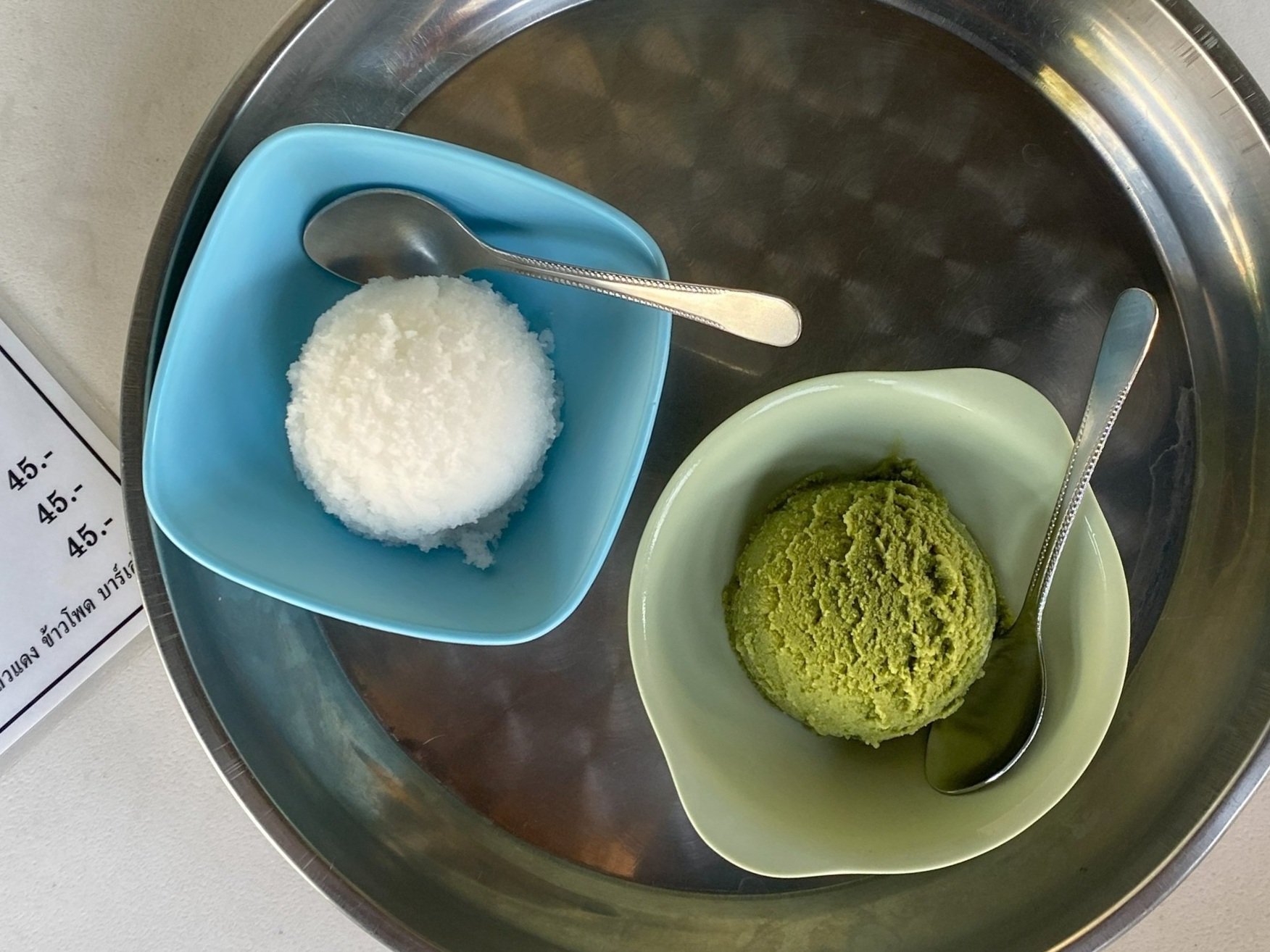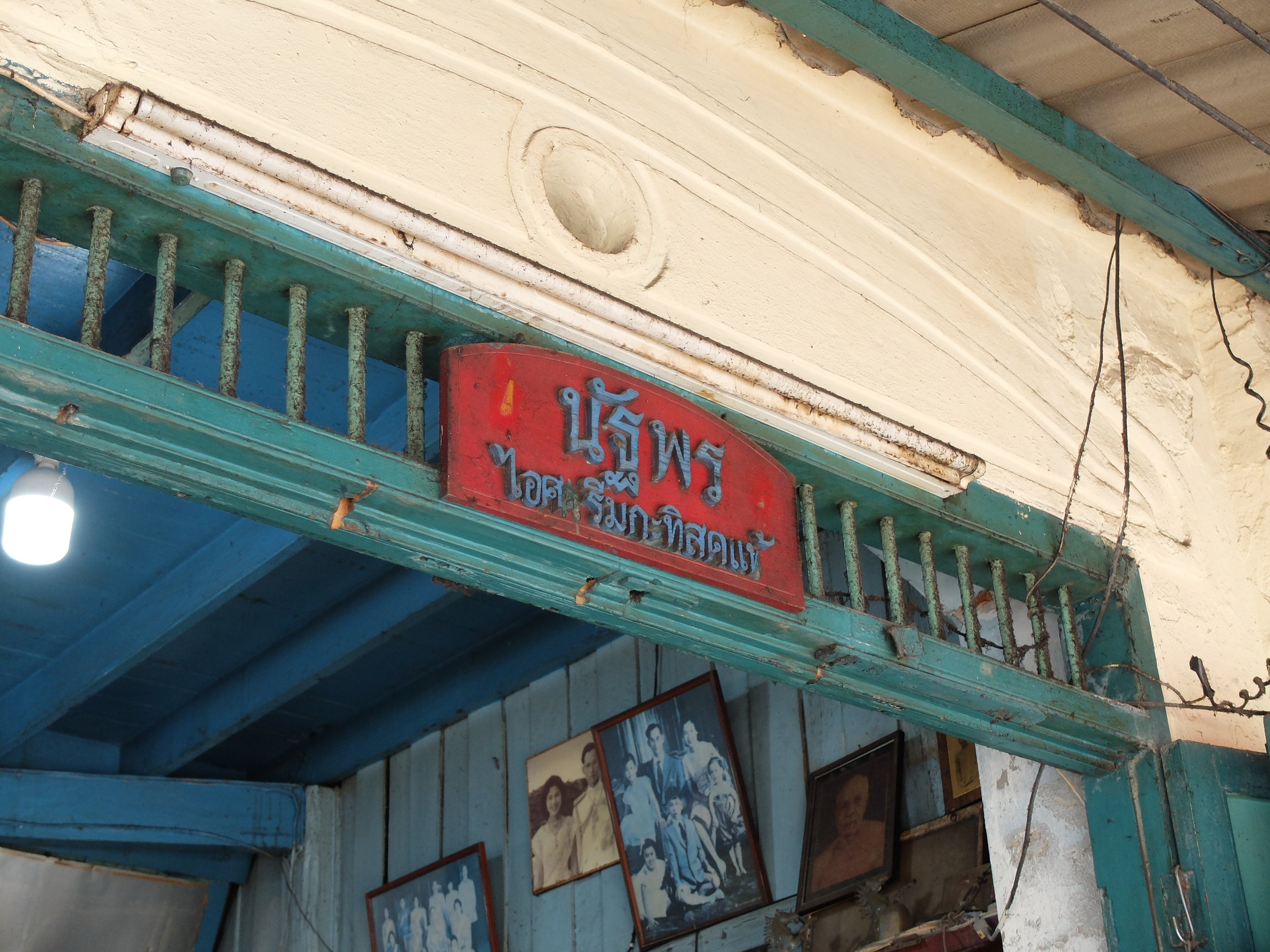Sweet, Cooling, and Refreshing: 5 Traditional Thai Desserts You Must Try for this summer!
Summer has officially arrived, and as everyone knows, summer in Thailand is extremely hot! And if you’re into Thai food, which is often rich in bold flavors, it can make you feel even hotter.
But did you know that Thai cuisine isn’t just about spicy and fiery dishes as you all may think? In this hot season, we’d love to introduce you to traditional Thai desserts that are perfect for cooling you down! These desserts are not only refreshing but also fragrant, sweet, and absolutely delicious.
Today, we’re bringing you 5 classic Thai desserts from traditional dessert shops in the Old Town area that you simply must try!
1. Khao Niaow Ma Muang (Mango Sticky Rice) – Saleethip [ ข้าวเหนียวมะม่วง - สาลี่ทิพย์
Location: 379/16 Itsaraphap Road, Wat Arun, Bangkok Yai, Bangkok, Thailand
Opening Hours: 08:00 - 19:00 (Open every day)
Let’s start with one of Thailand’s most famous and globally recognized desserts—Mango Sticky Rice!. Mango Sticky Rice is the perfect balance of creamy coconut milk, chewy sticky rice, crunchy mung beans, and fresh, sweet mango. The shop we’re recommending is a long-standing traditional establishment that has been open for nearly 70 years in the Thonburi district just around MRT Itsaraphap. Locally known among people in the area!
"Our journey of flavors began in 1957, and today, Saleethip Mango Sticky Rice stands as a testament to our heritage and dedication. Each dish carries the essence of our Chinese ancestry, weaving tradition and innovation, like our Mango Sticky Rice enriched with coconut cream. Our commitment to excellence is echoed through meticulously sourced ingredients, preserving the heart of local markets in every bite."
Saleethip Mango Sticky Rice is a respected family-run Thai dessert shop that has been serving customers since 1957. Now in its third generation, the shop takes pride in its time-honored recipe, passed down from the paternal grandmother, whose Chinese heritage lends a delicate and distinctive flavor to the desserts.Until nowadays, "Saleethip" remains, serving as a reminder of the shop’s rich and diverse history.
The kitchen at Saleethip is a treasure trove of traditional ingredients and artisanal craftsmanship. The mangoes used in their dishes are sourced from the renowned Damnoen Saduak Market, a hub for high-quality seasonal mangoes. The shop offers two premium varieties: Nam Dok Mai (น้ำดอกไม้), known for its sweet and firm texture, and Ok Rong (อกร่อง), which has a perfectly balanced sweet and slightly tangy taste. When purchasing mango sticky rice at Saleethip, you can choose your preferred mango variety, ensuring a flavor experience that matches your personal preference!
Many essential ingredients are carefully selected from Pho Sam Ton Market, a well-known local market famous for its fresh and high-quality produce. This commitment to sourcing from local markets reflects Saleethip’s dedication to maintaining the highest standards and preserving the authentic taste of traditional Thai desserts.
🌟Apart from Mango Sticky Rice, the shop also offers other unique toppings such as black bean steamed custard and flavored shrimp or fish that you should try.
2. I-tim Kati (Coconut Ice Cream) – Natthaphon [ ไอศกรีมกะทิ - นัฐพร ]
Location: 94 Phraeng Phuthon Road, San Chao Pho Suea, Phra Nakhon, Bangkok, Thailand
Opening Hours: 09:00 - 17:00 (Closed on Sundays)
Next up, Coconut Ice Cream! This shop offers not just the classic coconut flavor but a variety of options, plus you can add toppings like sticky rice, palm seeds, sweet corn, and roasted peanuts. That’s how the Thai enjoy their ice cream! Did you know? Coconut ice cream was once a treat exclusive in the Thai royal courts.
Back in the reign of King Rama IV or in the mid 18 th century, ice was considered a special treat in Siam’s hot and humid weather. Thailand imported ice-making machines for the first time, making ice cream an expensive luxury. Initially, Thai coconut ice cream was made by freezing young coconut water mixed with roasted tamarind seeds, resulting in an icy, sorbet-like texture. Later, the recipe was influenced by Western-style ice cream, using milk and cream. However, finding good quality milk and cream was such a challenge.
As a result, over time, locals adapted the recipe, replacing dairy with something easy to find. Fresh coconut milk was introduced, giving birth to the iconic Thai coconut ice cream we know today!
👍Our favourite flavor is fresh milk ice cream with sticky rice and sweet corn. The other pick from us would be black sesame ice cream and the classic coconut ice cream.
3. Tub Tim Krob (Water Chestnut in Coconut Milk) – Mae Duangporn (Wongwian Yai) [ทับทิบกรอบ - วงเวียนใหญ่]
Location: 184 Lat Ya Road, Khlong San, Bangkok, Thailand
Opening Hours: 08:30 - 20:30 (Open every day)
"Tab Tim Krob Wong Wian Yai" is a traditional Thai dessert recipe that has been carefully safeguarded and cherished by a Thai-Chinese family, whose ancestral roots trace back to Thailand. This recipe originated with the family's great-grandmother and has been faithfully passed down through generations, preserving its authenticity since the reign of King Rama V ( late 18th century).
“People might see Tab Tim Krob as a common dessert, but when we look at what we have created for generations, it becomes an ancient recipe that has been passed down through history. It’s a recipe filled with with stories and a sense of pride in our heritage” — Khun Imm, the owner
Today, the recipe continues to be inherited by the younger generation of the family, who are dedicated to maintaining the legacy of "Tab Tim Krob Wong Wian Yai," which has endured for over 40 years. The dessert's charm lies in its meticulous selection of high-quality ingredients and the delicate craftsmanship involved in its preparation. Its signature vibrant ruby-red color sets it apart from the more common versions of Tab Tim Krob found elsewhere.
Crunchy water chestnuts are combined with fresh coconut meat and specially sourced coconut milk from southern Thailand, resulting in a distinct and refreshing taste. This dessert has captivated travelers from around the world, particularly Japanese tourists who appreciate its simplicity and unique, traditional Thai flavors.
🌟Here apart from the classic “Tub Tim Krob” they also offer the addition of “Salim” version which is colorful noodles in sweetened coconut milk. The noodles are made from mung bean flour then infused with the fragrance of jasmine water and pandan juice.
If you ask about our top pick? it would be the classic “Tub Tim Krob” for sure! with its crunchy texture and creamy taste from the fragranced coconut milk. This refreshing treat is just perfect for cooling down on a hot day!
4. Singapore Lod Chong (Pandan Rice Flour Noodles in Coconut Milk) – Original Shop at Yaowarat (Mho Mi Intersection) [ลอดช่องสิงคโปร์ - เยาวราช]
Location: Mho Mi Intersection, Charoen Krung Road, Bangkok, Thailand
Opening Hours: 10:30 - 18:30 (Closed on Thursdays)
Lod Chong is a classic Thai dessert made from tapioca flour and pandan leaves, served in sweet coconut milk and crushed ice, creating a refreshing and creamy treat! Similar to Cendol, its green noodles resemble worms, and you can find variations of this dessert across Southeast Asian countries.
Image Credit: Wongnai
But why is it called "Singapore Lod Chong"? Is it from Singapore? Not at all! The name actually comes from a stand alone cinema called “Singapore Theater,” which was built over 80 years ago at the entrance of Yaowarat (Bangkok’s Chinatown). Then, how did this version of Lod Chong become famous? Here’s the story: near the cinema, a Chinese restaurant named "Singapore Pochana” started selling a new version of “Lod Chong” which was made from tapioca flour instead of the traditional rice flour recipe, resulting in a chewy texture.
The dessert became so popular among moviegoers that people started calling it “Lod Chong from Singapore Theater” but over time, the words “Theater” were dropped, leaving us with just "Lod Chong Singapore” and since then this unique version of Lod Chong is now sold all over Thailand!
🌟Now in its third generation, this Lod Chong shop remains a legend in Chinatown, harking back to the golden era of standalone cinemas in Bangkok. We recommend trying it with jackfruit as an alternative to the basic version. It adds a touch of fruity and tangy flavor to the sweet, creamy, and icy coconut milk!
5. Grass Jelly – Ama’s Traditional Recipe at Baan Agong Ama [เฉาก๊วย-บ้านอากงอาม่า]
Location: 253 Somdet Chao Phraya 3 Alley, Khlong San, Bangkok, Thailand
Opening Hours: 10:00 - 18:00 (Closed on Wednesdays)
Lastly, we have Grass Jelly (Chao Guay), a chewy, bouncy black jelly that has been enjoyed in Thailand for centuries. This dessert is the perfect refreshing treat for a hot summer day, with its mild sweetness and the icy, cooling sensation it provides. But Grass Jelly is more than just a dessert—it also has health benefits!
Originally brought to Thailand by Chinese immigrants, Grass Jelly is made from a plant in the mint family, known as Mesona Chinensis. The Thai name "Chao Guay" comes from the Chinese words: "Chao" (草) means "grass." and "Guay" (粿) means "dessert." That’s why it’s called "Grass Jelly" in English!
In the past, Thailand had to import dried Grass Jelly plants from China, but today, the plant is grown locally, making Grass Jelly widely available throughout the country. This delicacy holds valuable health benefits, particularly in combating the heat of the Thai climate.
Nestled in the Thonburi area is a legendary fish sauce factory that stands as a testament to the enduring legacy of a Chinese family. Here, Ama’s Grass Jelly traces its roots back to a 100-year-old family recipe, the formula has remained unaltered, preserving the distinct flavors that have delighted countless palates for generations. Crafted with ancestral wisdom of, this timeless treat is served in a century-old wooden house by the Chao Phraya River. It’s a must-visit spot for those who love authentic, old-town charm and want to enjoy riverside life like in the past.
“Embracing our uniqueness in the world of desserts and presenting it to those who wish to experience our own version of Ama’s recipes is more significant than striving to be different in an out-of-the-ordinary sense.” — The Grandparents’ House
🌟We suggest visiting in the morning or evening, as the shop gets quite busy in the afternoon!
Perfect cultural treats in the hot summer days while exploring Thailand!
If you’re looking for ways to beat the heat while exploring Bangkok’s old town, our pick for five traditional Thai desserts are a must-try! From the creamy goodness of Mango Sticky Rice to the cool, chewy texture of Grass Jelly. Each dessert has its own special story and cultural meaning! So, the next time you're in Bangkok, be sure to visit these hidden gems and experience the true taste of traditional Thai sweets! Join us for a deeper experience with our local experts, or explore on your own with our self-guided web tour, and savor the authentic flavors firsthand!












